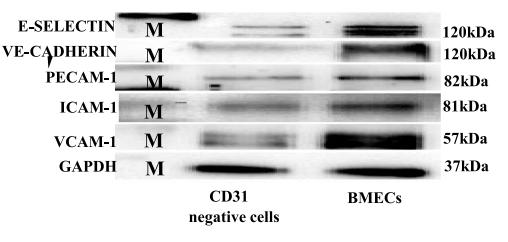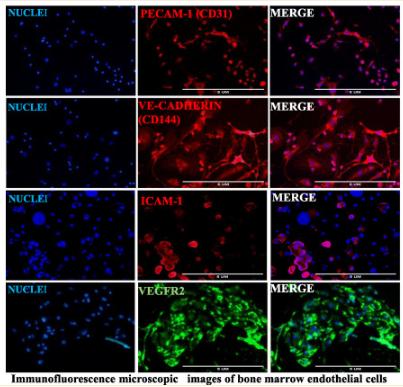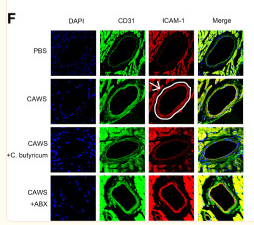ICAM1 Antibody - #AF6088
| Product: | ICAM1 Antibody |
| Catalog: | AF6088 |
| Description: | Rabbit polyclonal antibody to ICAM1 |
| Application: | WB IHC IF/ICC |
| Reactivity: | Human, Mouse, Rat, Monkey |
| Prediction: | Rabbit |
| Mol.Wt.: | 92kDa, 57 kDa; 58kD(Calculated). |
| Uniprot: | P05362 |
| RRID: | AB_2834982 |
Product Info
*The optimal dilutions should be determined by the end user.
*Tips:
WB: For western blot detection of denatured protein samples. IHC: For immunohistochemical detection of paraffin sections (IHC-p) or frozen sections (IHC-f) of tissue samples. IF/ICC: For immunofluorescence detection of cell samples. ELISA(peptide): For ELISA detection of antigenic peptide.
Cite Format: Affinity Biosciences Cat# AF6088, RRID:AB_2834982.
Fold/Unfold
Antigen identified by monoclonal antibody BB2; BB 2; BB2; CD 54; CD_antigen=CD54; CD54; Cell surface glycoprotein P3.58; Human rhinovirus receptor; ICAM 1; ICAM-1; ICAM1; ICAM1_HUMAN; intercellular adhesion molecule 1 (CD54), human rhinovirus receptor; Intercellular adhesion molecule 1; Major group rhinovirus receptor; MALA 2; MALA2; MyD 10; MyD10; P3.58; Surface antigen of activated B cells, BB2;
Immunogens
- P05362 ICAM1_HUMAN:
- Protein BLAST With
- NCBI/
- ExPASy/
- Uniprot
MAPSSPRPALPALLVLLGALFPGPGNAQTSVSPSKVILPRGGSVLVTCSTSCDQPKLLGIETPLPKKELLLPGNNRKVYELSNVQEDSQPMCYSNCPDGQSTAKTFLTVYWTPERVELAPLPSWQPVGKNLTLRCQVEGGAPRANLTVVLLRGEKELKREPAVGEPAEVTTTVLVRRDHHGANFSCRTELDLRPQGLELFENTSAPYQLQTFVLPATPPQLVSPRVLEVDTQGTVVCSLDGLFPVSEAQVHLALGDQRLNPTVTYGNDSFSAKASVSVTAEDEGTQRLTCAVILGNQSQETLQTVTIYSFPAPNVILTKPEVSEGTEVTVKCEAHPRAKVTLNGVPAQPLGPRAQLLLKATPEDNGRSFSCSATLEVAGQLIHKNQTRELRVLYGPRLDERDCPGNWTWPENSQQTPMCQAWGNPLPELKCLKDGTFPLPIGESVTVTRDLEGTYLCRARSTQGEVTRKVTVNVLSPRYEIVIITVVAAAVIMGTAGLSTYLYNRQRKIKKYRLQQAQKGTPMKPNTQATPP
Predictions
Score>80(red) has high confidence and is suggested to be used for WB detection. *The prediction model is mainly based on the alignment of immunogen sequences, the results are for reference only, not as the basis of quality assurance.
High(score>80) Medium(80>score>50) Low(score<50) No confidence
PTMs - P05362 As Substrate
| Site | PTM Type | Enzyme | Source |
|---|---|---|---|
| S43 | Phosphorylation | Uniprot | |
| T62 | O-Glycosylation | Uniprot | |
| T62 | Phosphorylation | Uniprot | |
| N130 | N-Glycosylation | Uniprot | |
| N145 | N-Glycosylation | Uniprot | |
| N183 | N-Glycosylation | Uniprot | |
| N202 | N-Glycosylation | Uniprot | |
| Y207 | Phosphorylation | Uniprot | |
| T211 | Phosphorylation | Uniprot | |
| T217 | Phosphorylation | Uniprot | |
| S223 | Phosphorylation | Uniprot | |
| N267 | N-Glycosylation | Uniprot | |
| S275 | Phosphorylation | Uniprot | |
| N296 | N-Glycosylation | Uniprot | |
| S323 | Phosphorylation | Uniprot | |
| K359 | Ubiquitination | Uniprot | |
| N385 | N-Glycosylation | Uniprot | |
| Y501 | Phosphorylation | Uniprot | |
| Y512 | Phosphorylation | Uniprot | |
| K519 | Ubiquitination | Uniprot | |
| T521 | Phosphorylation | Uniprot | |
| K524 | Ubiquitination | Uniprot | |
| T527 | Phosphorylation | Uniprot | |
| T530 | Phosphorylation | Uniprot |
Research Backgrounds
ICAM proteins are ligands for the leukocyte adhesion protein LFA-1 (integrin alpha-L/beta-2). During leukocyte trans-endothelial migration, ICAM1 engagement promotes the assembly of endothelial apical cups through ARHGEF26/SGEF and RHOG activation.
(Microbial infection) Acts as a receptor for major receptor group rhinovirus A-B capsid proteins.
(Microbial infection) Acts as a receptor for Coxsackievirus A21 capsid proteins.
(Microbial infection) Upon Kaposi's sarcoma-associated herpesvirus/HHV-8 infection, is degraded by viral E3 ubiquitin ligase MIR2, presumably to prevent lysis of infected cells by cytotoxic T-lymphocytes and NK cell.
Monoubiquitinated, which is promoted by MARCH9 and leads to endocytosis.
Membrane>Single-pass type I membrane protein.
Homodimer (Probable). Interacts with MUC1 and promotes cell aggregation in epithelial cells. Interacts with ARHGEF26/SGEF. Interacts (on T cell side) with CD81, CD247 and CD9 at immunological synapses between antigen-presenting cells and T cells.
(Microbial infection) Interacts with major receptor group rhinovirus A-B capsid proteins.
(Microbial infection) Interacts with Coxsackievirus A21 capsid proteins.
Belongs to the immunoglobulin superfamily. ICAM family.
Research Fields
· Environmental Information Processing > Signal transduction > NF-kappa B signaling pathway. (View pathway)
· Environmental Information Processing > Signaling molecules and interaction > Cell adhesion molecules (CAMs). (View pathway)
· Environmental Information Processing > Signal transduction > TNF signaling pathway. (View pathway)
· Human Diseases > Infectious diseases: Parasitic > African trypanosomiasis.
· Human Diseases > Infectious diseases: Parasitic > Malaria.
· Human Diseases > Infectious diseases: Bacterial > Staphylococcus aureus infection.
· Human Diseases > Infectious diseases: Viral > Influenza A.
· Human Diseases > Infectious diseases: Viral > HTLV-I infection.
· Human Diseases > Infectious diseases: Viral > Epstein-Barr virus infection.
· Human Diseases > Immune diseases > Rheumatoid arthritis.
· Human Diseases > Cardiovascular diseases > Viral myocarditis.
· Organismal Systems > Immune system > Natural killer cell mediated cytotoxicity. (View pathway)
· Organismal Systems > Immune system > Leukocyte transendothelial migration. (View pathway)
References
Application: WB Species: human Sample: HUVECs
Application: WB Species: Human Sample: HUVECs
Application: WB Species: mouse Sample: primary bone marrow endothelial cells
Application: IF/ICC Species: mouse Sample: primary bone marrow endothelial cells
Application: WB Species: Mice Sample: bMECs
Application: IF/ICC Species: Mice Sample: BMECs
Application: IF/ICC Species: Mouse Sample:
Application: WB Species: Mice Sample: melanoma cells
Application: WB Species: Mouse Sample: Spinal cord
Restrictive clause
Affinity Biosciences tests all products strictly. Citations are provided as a resource for additional applications that have not been validated by Affinity Biosciences. Please choose the appropriate format for each application and consult Materials and Methods sections for additional details about the use of any product in these publications.
For Research Use Only.
Not for use in diagnostic or therapeutic procedures. Not for resale. Not for distribution without written consent. Affinity Biosciences will not be held responsible for patent infringement or other violations that may occur with the use of our products. Affinity Biosciences, Affinity Biosciences Logo and all other trademarks are the property of Affinity Biosciences LTD.









